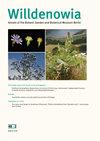缅甸白垩纪琥珀中的卷柏属
IF 1.4
3区 生物学
Q2 PLANT SCIENCES
引用次数: 2
摘要
摘要:卷柏属(Selaginellales,Selaginellaceae)是石松植物中物种最多的属,目前已确认约750种,也是维管植物中最大的属之一。然而,这种物种丰富度的进化史在很大程度上仍未解决。最近的研究表明,卷柏属在白垩纪中期就已经多种多样,并表明卷柏亚属。Stachygyandrum至少可以追溯到大约1亿年前的被子植物陆地革命。在这里,我们根据缅甸白垩纪中期克钦琥珀中保存的可育芽和孢子,描述了20个新的卷柏化石物种,并对之前描述的S.cretacea进行了修正。其中10个物种(C.cilifera、S.cretacea、S.grimaldi、S.heteroporangiata、S.longifimbriata、S.minutissima、S.ohlhoffiorum、S.patrickmueleri、S.villosa、S.wangxinii)代表S.subg。因为它们具有不等叶的茎。其他11个物种具有等叶的频闪性。其中两个(S.isophylla,S.wunderlichiana)被初步归入S.subg。Ericetorum,而其他(S.amplexicalis,S.aurita,S.heinrichsii,S.konijnenburgie,S.obscura,S.ovoide,S.pellucida,S.tomescui,S.wangboi)不能归入任何化石或现存亚属。这项研究中描述的化石几乎复制了克钦琥珀中游离孢子植物的记录。隐生植物的丰富性和多样性,以及分类群中不存在旱生植物,表明这种琥珀的源林下层湿度一直很高。引文:Schmidt A.R.、Korall P.、Krings M.、Weststrand S.、Bergschneider L.、Sadowski E.-M、Bechtler J.、Rikkinen J.和Regalado L.2022:缅甸白垩纪琥珀中的卷柏属Willdenowia 52:179-245。该记录的版本于2022年9月22日首次在线发布,随后将于2022年8月出版。本文章由计算机程序翻译,如有差异,请以英文原文为准。
Selaginella in Cretaceous amber from Myanmar
Abstract: Selaginella (Selaginellales, Selaginellaceae) is the most speciose genus of lycophytes and, with approximately 750 recognized present-day species, also one of the largest genera of vascular plants. However, the evolutionary history of this species richness remains largely unresolved. Recent research suggests that Selaginella was diverse already in the mid-Cretaceous and shows that S. subg. Stachygynandrum dates back at least to the incipient Angiosperm Terrestrial Revolution some 100 million years ago. Here, we describe 20 new fossil-species of Selaginella based on fertile shoots and spores preserved in mid-Cretaceous Kachin amber from Myanmar and emend the previously described S. cretacea. Ten of the species (S. ciliifera, S. cretacea, S. grimaldii, S. heterosporangiata, S. longifimbriata, S. minutissima, S. ohlhoffiorum, S. patrickmuelleri, S. villosa, S. wangxinii) represent S. subg. Stachygynandrum because they possess anisophyllous strobili. The other eleven species have isophyllous strobili. Two of them (S. isophylla, S. wunderlichiana) are tentatively assigned to S. subg. Ericetorum, whereas the others (S. amplexicaulis, S. aurita, S. heinrichsii, S. konijnenburgiae, S. obscura, S. ovoidea, S. pellucida, S. tomescui, S. wangboi) cannot be placed into any fossil or extant subgenus. The fossils described in this study nearly duplicate the documented record of free-sporing plants from Kachin amber. The abundance and diversity of cryptogams, along with the absence of xerophytes among the taxa, is suggestive of constantly high humidity in the understory of the source forests of this amber. Citation: Schmidt A. R., Korall P., Krings M., Weststrand S., Bergschneider L., Sadowski E.-M., Bechteler J., Rikkinen J. & Regalado L. 2022: Selaginella in Cretaceous amber from Myanmar. – Willdenowia 52: 179–245. Version of record first published online on 22 September 2022 ahead of inclusion in August 2022 issue.
求助全文
通过发布文献求助,成功后即可免费获取论文全文。
去求助
来源期刊

Willdenowia
PLANT SCIENCES-
CiteScore
4.60
自引率
5.30%
发文量
17
审稿时长
>12 weeks
期刊介绍:
Willdenowia is an international peer-reviewed journal publishing original research articles in English from the entire fields of plant, algal and fungal systematics, covering the evolution, taxonomy and nomenclature of these organisms as well as related fields such as floristics and plant geography. Articles on phylogeny and molecular systematics are especially welcome, as are review articles. Descriptions of new taxa may be considered, but only if supported by robust evidence. Narrowly regional studies of widespread taxa, routine typifications, checklists and new floristic records are generally not considered (excluding contributions to the Euro+Med-Checklist Notulae). Authors are encouraged to deposit duplicates of their material, especially nomenclatural types, in the Berlin herbarium (B).
 求助内容:
求助内容: 应助结果提醒方式:
应助结果提醒方式:


